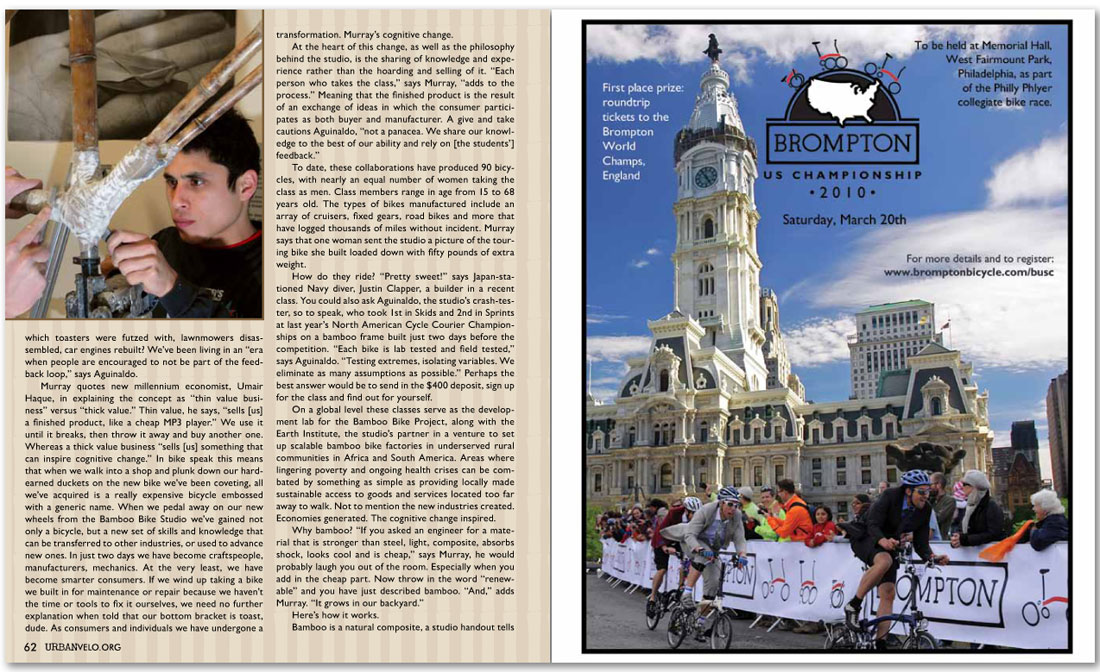


which toasters were futzed with, lawnmowers disassembled, car engines rebuilt? We’ve been living in an “era when people are encouraged to not be part of the feedback loop,” says Aguinaldo.
Murray quotes new millennium economist, Umair Haque, in explaining the concept as “thin value business” versus “thick value.” Thin value, he says, “sells [us] a finished product, like a cheap MP3 player.” We use it until it breaks, then throw it away and buy another one. Whereas a thick value business “sells [us] something that can inspire cognitive change.” In bike speak this means that when we walk into a shop and plunk down our hard-earned duckets on the new bike we’ve been coveting, all we’ve acquired is a really expensive bicycle embossed with a generic name. When we pedal away on our new wheels from the Bamboo Bike Studio we’ve gained not only a bicycle, but a new set of skills and knowledge that can be transferred to other industries, or used to advance new ones. In just two days we have become craftspeople, manufacturers, mechanics. At the very least, we have become smarter consumers. If we wind up taking a bike we built in for maintenance or repair because we haven’t the time or tools to fix it ourselves, we need no further explanation when told that our bottom bracket is toast, dude. As consumers and individuals we have undergone a transformation. Murray’s cognitive change.
At the heart of this change, as well as the philosophy behind the studio, is the sharing of knowledge and experience rather than the hoarding and selling of it. “Each person who takes the class,” says Murray, “adds to the process.” Meaning that the finished product is the result of an exchange of ideas in which the consumer participates as both buyer and manufacturer. A give and take cautions Aguinaldo, “not a panacea. We share our knowledge to the best of our ability and rely on [the students’] feedback.”
To date, these collaborations have produced 90 bicycles, with nearly an equal number of women taking the class as men. Class members range in age from 15 to 68 years old. The types of bikes manufactured include an array of cruisers, fixed gears, road bikes and more that have logged thousands of miles without incident. Murray says that one woman sent the studio a picture of the touring bike she built loaded down with fifty pounds of extra weight.
How do they ride? “Pretty sweet!” says Japan-stationed Navy diver, Justin Clapper, a builder in a recent class. You could also ask Aguinaldo, the studio’s crash-tester, so to speak, who took 1st in Skids and 2nd in Sprints at last year’s North American Cycle Courier Championships on a bamboo frame built just two days before the competition. “Each bike is lab tested and field tested,” says Aguinaldo. “Testing extremes, isolating variables. We eliminate as many assumptions as possible.” Perhaps the best answer would be to send in the $400 deposit, sign up for the class and find out for yourself.
On a global level these classes serve as the development lab for the Bamboo Bike Project, along with the Earth Institute, the studio’s partner in a venture to set up scalable bamboo bike factories in underserved rural communities in Africa and South America. Areas where lingering poverty and ongoing health crises can be combated by something as simple as providing locally made sustainable access to goods and services located too far away to walk. Not to mention the new industries created. Economies generated. The cognitive change inspired.
Why bamboo? “If you asked an engineer for a material that is stronger than steel, light, composite, absorbs shock, looks cool and is cheap,” says Murray, he would probably laugh you out of the room. Especially when you add in the cheap part. Now throw in the word “renewable” and you have just described bamboo. “And,” adds Murray. “It grows in our backyard.”
Here’s how it works.
Bamboo is a natural composite, a studio handout tells